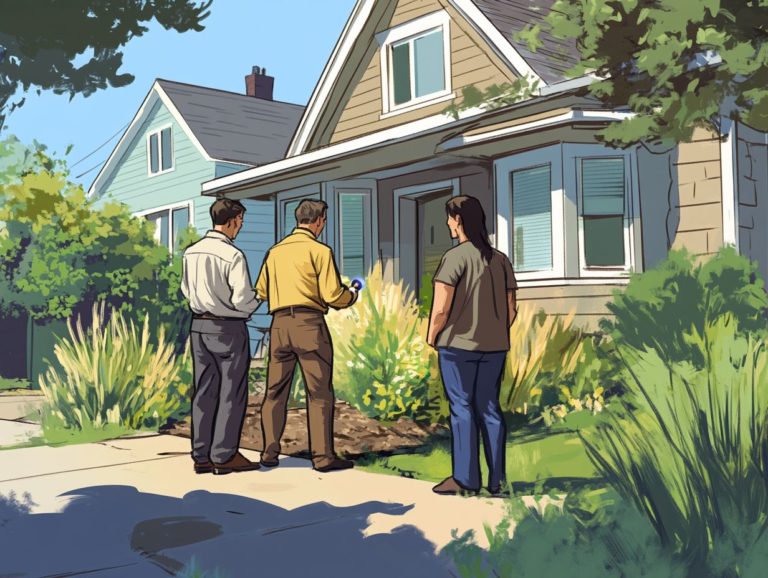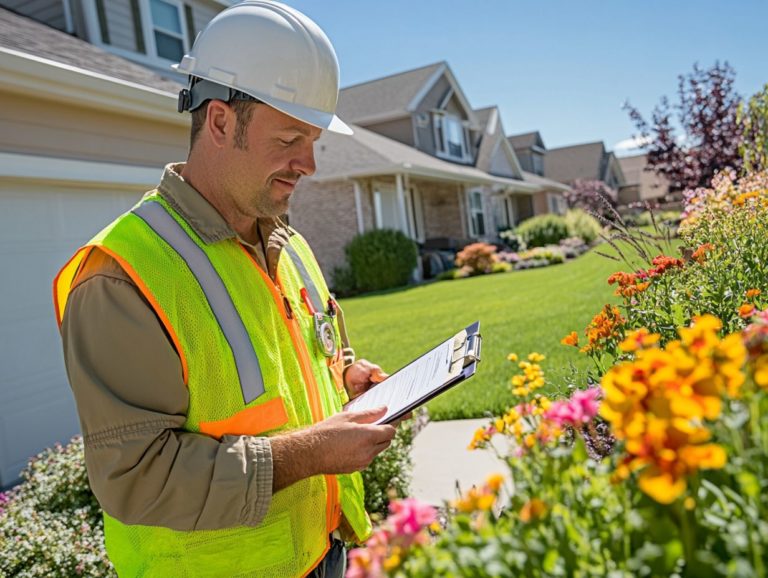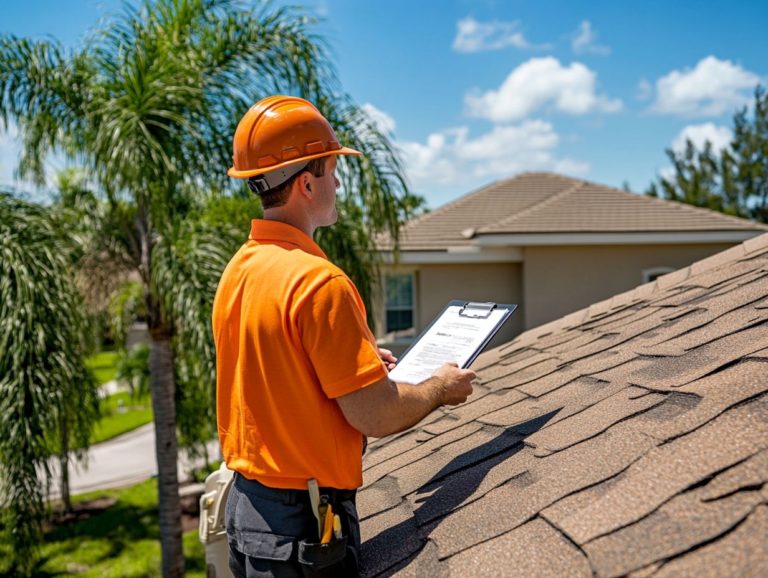The Most Overlooked Areas in Home Inspections
When considering home inspections, many homeowners tend to concentrate on the obvious concerns such as the roof or plumbing.
However, there are several crucial areas that frequently go unnoticed, resulting in unexpected expenses in the future.
This article shines a light on the most commonly overlooked aspects of home inspections, ranging from hidden attic issues to disregarded safety hazards.
By grasping these potential pitfalls, you can better protect your investment and guarantee a comprehensive evaluation of your home s condition.
Contents
- Key Takeaways:
- 1. Roof and Attic
- 2. Electrical System
- 3. Plumbing and Drainage
- 4. Foundation and Structural Issues
- 5. HVAC System
- 6. Chimney and Fireplace
- 7. Exterior Siding and Trim
- 8. Windows and Doors
- 9. Insulation and Ventilation
- 10. Appliances and Fixtures
- 11. Garage and Carport
- 12. Landscaping and Drainage
- 13. Safety Hazards
- 14. Crawl Space or Basement
- 15. Additional Structures on the Property
- What Are the Most Commonly Overlooked Items in a Home Inspection?
- Frequently Asked Questions
- What are some of the most commonly overlooked areas in home inspections?
- Why are these areas often overlooked?
- How can I ensure that these areas are thoroughly inspected during my home inspection?
- What are the potential consequences of overlooking these areas during a home inspection?
- Are there any warning signs that these areas may have been overlooked during a home inspection?
- If I think these areas were missed, what should I do?
Key Takeaways:

Roof and attic issues are often overlooked in home inspections, but they can lead to costly repairs and safety hazards if not addressed.
The electrical system is a critical component of a home, yet it is often overlooked in inspections. Faulty wiring and outdated systems can pose significant safety risks.
Plumbing and drainage problems can be hidden and hard to detect, but they can cause major issues such as water damage, mold growth, and sewage backups.
1. Roof and Attic
The roof and attic are vital components of your home that deserve meticulous inspections. By identifying potential issues like roof leaks and inadequate attic insulation, you can prevent moisture problems that could compromise the safety and structural integrity of your property.
Neglecting these essential areas can lead to costly repairs and diminish your home’s value over time. Insufficient insulation not only creates energy inefficiency but also inflates your heating and cooling expenses.
Improper ventilation can trap heat and moisture in the attic, fostering mold growth and wood rot.
To mitigate these risks, hire experts for regular maintenance checks. Professional evaluations can reveal hidden problems early, ensuring that both your roof and attic remain in peak condition and extending the lifespan of your home s structure.
2. Electrical System
A well-functioning electrical system is essential for your home, as electrical issues can lead to significant safety hazards. It s crucial for you as a homebuyer to prioritize a thorough home inspection that assesses the condition of wiring, outlets, and appliances.
Neglecting these components can result in dangerous scenarios, such as electrical fires, shocks, or equipment failures. Outdated wiring, overloaded circuits, and malfunctioning appliances can all heighten these risks.
Regularly check for frayed wires, test GFCI (Ground Fault Circuit Interrupter) outlets, and avoid overloading sockets with too many devices. Hiring a qualified electrician for professional evaluations can uncover hidden issues and ensure your home’s electrical system meets current safety standards.
Taking this proactive approach gives you peace of mind and helps prevent costly repairs down the line.
3. Plumbing and Drainage
Plumbing and drainage systems are essential for ensuring the functionality and safety of your home. A thorough plumbing inspection enables you as a homebuyer to pinpoint potential issues like leaks, clogs, and water damage that could spiral into costly repairs.
If left unaddressed, these minor problems can escalate into major headaches, including mold growth and structural damage that undermine the integrity of your home. Frequent issues, such as leaking pipes, can inflate your water bills and create unhealthy living conditions.
This is why it s vital for homeowners to conduct regular visual inspections of their plumbing systems. By identifying early signs of wear and tear, you can take proactive steps to effectively prevent significant water damage from neglected plumbing.
Don t wait! Schedule your home inspection now to protect your investment!
4. Foundation and Structural Issues
The foundation serves as the cornerstone of a home s structural integrity. Potential issues, such as cracks and settling, can jeopardize not only safety but also the longevity of your property. It is imperative for you, as a home buyer, to conduct a thorough home inspection.
Foundational problems often reveal themselves through visible cracks in walls, uneven floors, or doors that refuse to budge. These are early warning signs that deserve your immediate attention. Inspectors use various assessment techniques visual inspections, laser leveling, and soil testing to evaluate the underlying conditions affecting the foundation.
Understanding these signs and their implications is crucial. Neglecting these issues can lead to extensive damage and costly repairs, ultimately compromising the stability of your new home.
5. HVAC System
The HVAC system (Heating, Ventilation, and Air Conditioning) plays a key role in keeping your home comfortable. Identifying HVAC issues during a home inspection can significantly impact energy efficiency and indoor air quality, which rely on proper ventilation and well-functioning equipment.
Common problems include inefficient units and inadequate ventilation, which can result in higher energy use and frustratingly high utility bills. Dealing with an underperforming air conditioning unit that struggles to maintain your desired temperature not only overworks the components but also shortens its lifespan.
Poor ventilation can allow indoor air pollutants to circulate, leading to discomfort and potential health concerns. To tackle these challenges, consistent maintenance is essential.
Simple measures, like changing air filters regularly and cleaning ductwork, can greatly enhance efficiency. Schedule routine inspections with a qualified technician to ensure that any emerging issues are addressed promptly.
6. Chimney and Fireplace

A chimney and fireplace can elevate the charm of your home, but they require regular inspections to prevent safety hazards such as blockages and a thick, flammable residue from burning wood.
These inspections are essential for spotting problems before they escalate. Ensure that the warmth and ambiance of your fireplace remain a source of comfort instead of a potential risk. Keep an eye out for signs of fireplace trouble, like smoke buildup or odd smells, as these could signal the need for immediate attention.
Regular cleaning is essential to keep your family safe don t wait to schedule it! Hiring a professional chimney sweep ensures thorough checks and provides invaluable maintenance tips for long-term safety and efficiency.
7. Exterior Siding and Trim
The exterior siding and trim of your home are not just attractive features; they are vital barriers against moisture and pests. A thorough home inspection is essential to ensure their integrity and identify maintenance needs.
With various siding materials available wood, vinyl, fiber cement, and metal it s important to understand the unique vulnerabilities each type presents. Wood siding often faces issues like rot and warping from excess moisture, while vinyl can warp or fade in extreme heat. Fiber cement is generally durable, but if not properly sealed, it may become susceptible to moisture infiltration.
Conducting regular visual inspections is crucial for catching these problems early. This proactive maintenance approach can help you mitigate the risk of pests invading your space and ultimately safeguard your home from costly repairs.
8. Windows and Doors
Windows and doors are vital for your home s energy efficiency and security. Conduct a thorough inspection to find potential problems like drafts, water damage, and faulty locks.
Overlooking these essential components can lead to soaring energy bills and a compromised sense of safety. Common problems often arise from improper sealing, allowing unwanted air to infiltrate or escape, which disrupts your heating and cooling efficiency.
Regular inspections will unveil these issues early, enabling you to take corrective action before they snowball into bigger problems. Simple maintenance tips, such as checking weatherstripping and ensuring locks function properly, can greatly enhance both your energy efficiency and peace of mind.
By focusing on these details, you can ensure that your windows and doors offer optimal protection and comfort for your home.
9. Insulation and Ventilation
Proper insulation and ventilation are critical for ensuring energy efficiency and indoor comfort in your home. As a home buyer, it s vital to pay close attention to these elements during an inspection.
Neglecting insulation and ventilation can lead to moisture buildup and soaring energy costs. You ll encounter various insulation options like fiberglass, foam, and cellulose. These materials help keep your home warm in winter and cool in summer.
Inadequate ventilation can result in stale air, mold growth, and inefficient airflow, diminishing your comfort. By regularly assessing your insulation quality and addressing ventilation concerns, you enhance your living environment and keep energy bills in check.
Recognizing areas that require improvement, such as upgrading insulation materials or installing more effective ventilation systems, is essential for achieving optimal energy efficiency and maintaining a healthy home.
10. Appliances and Fixtures
The condition of your appliances and fixtures plays a pivotal role in your home’s comfort and efficiency. A thorough home inspection helps uncover any defective appliances, ensuring everything is performing at its best.
During inspections, you may find issues like outdated refrigerators that strain energy performance or malfunctioning thermostats causing uneven heating. Look out for dishwashers with leaks and washing machines showing signs of wear, hindering their efficiency.
Regular inspections are a must to avoid costly repairs by addressing these problems before they escalate. By prioritizing maintenance and conducting timely inspections, you can enhance energy efficiency and lower your utility bills while extending the lifespan of your appliances.
11. Garage and Carport
The garage and carport are vital spaces for protecting your vehicles and storing belongings. Conducting a thorough home inspection is essential to uncover any safety hazards and maintenance needs affecting usability and security.
When inspecting these areas, keep an eye out for common issues like cracks in the concrete floor. Such cracks can lead to water accumulation, raising concerns about structural integrity. Check for rust or corrosion on metal parts and any drainage problems.
Proper ventilation is equally important; it helps prevent moisture buildup, which can lead to mold growth and unpleasant odors. Regularly inspect your garage and carport to keep them in top condition, perform routine cleanups, and check for leaks.
Reinforcing support beams and maintaining the roof can save you from costly repairs down the road, ensuring a safe and functional environment for both your vehicles and storage needs.
12. Landscaping and Drainage

Landscaping and drainage systems are important for stopping moisture problems in your home. Proper grading, or the angle of your yard, is essential for directing water away from your foundation. This helps prevent costly repairs, making inspections a must for new homeowners.
Effective landscaping involves thoughtful grading. You might encounter common grading challenges such as:
- Improper slope angles
- Compacted soil
- Debris blocking water flow
These issues can cause persistent puddles or erosion, which can compromise your home’s structural integrity. Regular checks can help you catch these problems before they escalate, allowing for timely interventions.
Act now to keep your property resilient against water damage and related repairs, maintaining both its beauty and functionality.
13. Safety Hazards
Identifying safety hazards is essential in the home inspection process. Potential issues can seriously jeopardize the well-being of residents, underscoring the importance of your awareness as a buyer in safeguarding your investment.
Often, problems like outdated electrical systems, poorly maintained roofs, and inadequate fire exits slip through the cracks during standard evaluations. Recognizing these hazards is crucial, as they can lead to significant repair costs later on.
Common concerns such as mold growth, carbon monoxide leaks, and inadequate ventilation should never be ignored. Thorough evaluations conducted by inspectors are essential for revealing these hidden risks. Stay informed about safety protocols to maintain a secure living environment.
Schedule a professional inspection today to safeguard your home!
14. Crawl Space or Basement
Crawl spaces and basements are often neglected during home inspections, yet they are important for stopping moisture problems and pest infestations. These areas can easily become breeding grounds for mold and mildew, jeopardizing your home s structural integrity.
Inadequate insulation in these spaces can lead to energy inefficiencies, resulting in higher utility bills and less comfortable living conditions. Pests like rodents and insects often seek refuge in these dark, damp environments, further endangering your home s safety and hygiene.
Act now to keep your living space healthy by conducting regular inspections and implementing effective strategies like proper ventilation and moisture barriers.
15. Additional Structures on the Property
Additional structures on your property like sheds, fences, and decks need thorough inspections to evaluate their condition and identify safety hazards that could affect your home ownership experience.
Understand the different types of these structures, as each has its own potential issues. For example, fences might succumb to weather damage, while decks could develop rot or have unstable railings, creating safety risks. Sheds may attract pests or suffer from moisture damage.
Regular inspections are crucial for uncovering these problems early, helping you avoid costly repairs and ensuring these structures enhance your property s overall appeal.
Don t wait schedule inspections to maintain your investment’s value!
What Are the Most Commonly Overlooked Items in a Home Inspection?
Many home buyers overlook essential aspects of a home inspection, often missing critical items that could lead to potential issues. This highlights the necessity of a thorough inspection checklist to elevate buyer awareness.
One commonly overlooked detail is the condition of the roof, which can easily escape notice during a casual walk-through. Buyers might also miss signs of water damage in concealed areas, such as beneath sinks or behind appliances, where lingering moisture can foster mold growth.
Electrical systems often fall by the wayside; outdated wiring can create safety hazards that aren t immediately apparent. Many buyers overlook the efficiency of the heating, ventilation, and air conditioning (HVAC) system, but its condition can significantly impact long-term costs.
Being proactive about these often-missed details can save you money and ensure your home is safe!
Frequently Asked Questions
What are some of the most commonly overlooked areas in home inspections?

Some of the most commonly overlooked areas in home inspections include the roof, electrical wiring, plumbing, insulation, and ventilation systems.
Why are these areas often overlooked?
These areas are often overlooked because they are not immediately visible and require specialized knowledge and equipment to inspect properly.
How can I ensure that these areas are thoroughly inspected during my home inspection?
You can ensure thorough inspections by hiring a qualified and experienced home inspector who follows a comprehensive checklist and has the necessary equipment and expertise.
What are the potential consequences of overlooking these areas during a home inspection?
The potential consequences of overlooking these areas can range from minor issues like leaks and drafts to major, costly repairs such as structural damage or fire hazards.
Are there any warning signs that these areas may have been overlooked during a home inspection?
Warning signs that these areas may have been overlooked include visible damage or wear and tear, unusual odors, and inconsistent heating or cooling.
If I think these areas were missed, what should I do?
If you think these areas were missed, request a re-inspection. It s important to discuss any concerns with your home inspector and review the initial inspection report before doing so.
Don t leave your investment to chance schedule a thorough home inspection today!






